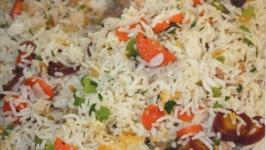Forest Gardens; The Basics
As the mainstream focus on food bends back toward local and natural, gardening trends tend to follow. While not everyone can (or should) find food by foraging, just a little time and space can bring the forest to your own yard. Done right, a food forest can conserve water, time and space.
*Notes:
- Food forests can be created on patios and balconies, though on a much smaller scale, with some modifications.
- Food forests are a great way to increase access to healthy food in communities. We can all advocate for parks and community spaces to include plans for these kinds of plantings.
A food forest is a man-made permaculture mimicry of the wild and diverse forest-based ecosystems found in nature, with plants specifically chosen to be both edible and beneficial to humans, animals and microbes. It includes a wide variety of perennial plants (such as fruit and nut trees), medicinal shrubs, flowers and roots and self-seeding annuals. Like its natural counterpart, it is meant to be self-sustaining, without much intervention.
The Layers of a Food Forest: Each layer allows sunlight to filter through, allowing full sun, partial sun and shade plants to exist side by side.
- Canopy: Tall trees including fruit, timber or nut trees, typically growing over 30 feet; walnuts, almonds, avocados
- Understory: Generally includes dwarf fruit trees, 10–30 feet tall; lemons, dwarf apples, pomegranates, stone fruit
- Vine: Includes grapes, berries, peas, cucumbers, passion fruit, nasturtium. Typically spans multiple layers depending on how they are trained
- Shrub/Brush: Fruiting, flowering bushes and medicinal shrubs that can reach up to 10 feet; blueberries, moringa, marshmallow, lemongrass, rosemary
- Herbaceous: These are the herbs, vegetables and edible flowers that can die off each year; bergamot, basil, spinach, peppers, tomatoes, crucifers, artichokes
- Ground cover: Sometimes overlaps with herbaceous layer; mostly shade tolerant and dense growth; thyme, oregano, fava beans, buckwheat, lettuces, nasturtium, sorrel, strawberries, melons and squashes
- Root: Edible root plants that can span multiple layers; carrots, burdock, dandelions, radishes, potatoes, ginger, taro
- Mycelial/Fungal: Microorganisms and fungal network in the soil that retains moisture and transports nutrients. Soil health is key to a thriving forest. Using biochar, compost and worms can help your forest start well.
The Network
- Multiple layers slow waterdrops and protect tender plants, also allowing the soil time to absorb more moisture.
- Leaves and dead plants provide a mulch layer, which keeps the soil moist and protects the microbial activity.
- Soil with lots of organic content and structure helps to clean water and save it for the dry summers.
- Worms and soil microbes consume the dead leaves and dying annuals to create rich, fertile topsoil.
- The flowering and fruiting plants provide food and habitat for pollinators and predators that in turn protect our food.
To get started: search the phrase “how to grow a food forest” for step-by-step guides, books and websites.









